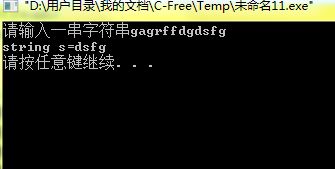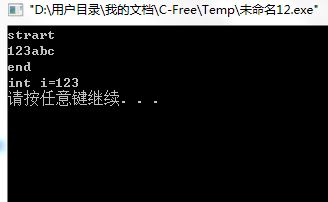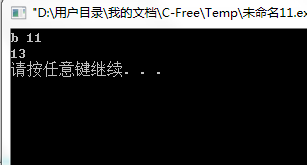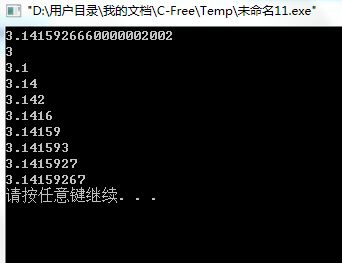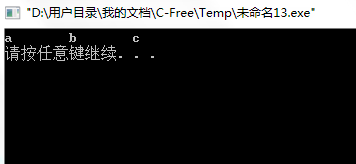- Python的一点基础教程------文件读写
卡提西亚
python开发语言
最近在看大佬写的Python教程自学,但是感觉有点头痛,因为大佬讲了一些底层的结构和原理,但是又没那么详细,然后作为一个初学者自学的情况下,看的很费劲.看完就有感而发,想写一篇更基础的教程,教会大家怎么去用它,尽量少的去讲原理.但是当然,你也需要有一定的编程语言基础,了解基本的语法和函数等功能.正所谓师傅领进门,修行在个人,有时候我们学了一个东西,如果觉得很有趣,自然就会去了解关于它的更多信息,但
- 导出docker-compse.yml中docker镜像成tar文件
青春不流名
eureka云原生
#!/bin/bash#确保脚本在正确的目录下运行SCRIPT_DIR=$(dirname"$(realpath"$0")")cd"$SCRIPT_DIR"||exit1#定义docker-compose文件路径COMPOSE_FILE="${SCRIPT_DIR}/docker-compose.yml"#创建导出目录EXPORT_DIR="${SCRIPT_DIR}/docker_images"
- Unity脚本--01-脚本书写规则-脚本生命周期-脚本调试-常用API
秦果
开发语言
一、脚本书写规则脚本:.cs的文本文件类文件作用:附加到游戏物体中,定义游戏对象行为指令的代码与C#类的区别:脚本只有字段和方法,没有自动属性和构造函数publicintA{get{returna;}set{a=value;}}属性定义了在unity中不会显示publicLifecycle(){Debug.Log("构造函数")//b=Time.time;}不要在脚本中写构造函数,因为不能在子线程
- python 脚本 遍历目录,并把目录下的非utf-8文件改成utf8
还债大湿兄
python开发语言数据库
从网上下载的qt项目我本地编译里面经常包含中文,提示编译不过,实际上以前经常手动转,发觉还是用脚本不,毕竟这次下的有点大,我只改.h.cpp#pythonD:\python\filetoUtf.pyE:\EasyCanvas-master\EasyCanvas-masterimportosimportcodecsimportargparseimportsysdefconvert_to_utf8_b
- python实现读取文件的指定某行内容
Fitz1318
Python3学习python
python实现读取文件的指定某行内容最近有一个需求就是读取一个文件中的指定某行的内容,现将方法记录如下importlinecache#这里填写你自己的文件位置和行号text=linecache.getline("../TestFile/test_C1.json",2)print(text)
- 【问题解决】pnpm : 无法将“pnpm”项识别为 cmdlet、函数、脚本文件或可运行程序的名称。
aPurpleBerry
问题解决前端
今天配置完poetry环境变量之后pnpm不能用了具体报错pnpm:无法将“pnpm”项识别为cmdlet、函数、脚本文件或可运行程序的名称。请检查名称的拼写,如果包括路径,请确保路径正确,然后再试一次。所在位置行:1字符:1+pnpmrundev+~~~~+CategoryInfo:ObjectNotFound:(pnpm:String)[],CommandNotFoundException+F
- HarmonyOS从入门到精通:WebView开发
逻极
harmonyos华为鸿蒙webviewUI前端实战
引言WebView是现代移动应用中不可或缺的组件,它使应用能够显示Web内容,实现混合开发。本文将详细介绍鸿蒙系统中WebView的开发技术,包括基本使用、性能优化和最佳实践。WebView基础知识1.WebView类型鸿蒙系统支持多种WebView实现:系统WebView自定义WebViewWeb组件2.WebView权限配置在开发WebView应用前,需要在配置文件中添加相关权限:{"modu
- Linux I/O 文件操作详解:从系统调用到实际工程应用
平凡灵感码头
linux学习linux运维服务器
一、写在前面在Linux或任何类Unix操作系统中,文件是一切的核心——无论是硬盘上的文本文件,还是串口设备、GPIO寄存器、甚至网络接口,几乎都被抽象为“文件”。理解Linux下的I/O文件操作机制,不仅是嵌入式开发的基础,也是进行系统编程与底层控制的关键。二、I/O的本质:一切皆文件Linux将外设抽象成文件的方式,统一了对各种资源的操作模型。你可以用open打开串口设备/dev/ttyS0,
- 【C++】atoi和std::stoi
bluebonnet27
编程语言#C++c++算法开发语言
两个将字符串转为int的方法atoi(C语言)atoi是C库中的一个函数,它定义在头文件里。其作用是把一个字符串转换为对应的整数。/*Convertastringtoaninteger.*/externintatoi(constchar*__nptr)__THROW__attribute_pure____nonnull((1))__wur;转换的原则如下:此函数接收一个以空字符'\0'结尾的字符串
- 使用 pip 命令下载 whl离线安装包、安装
三希
pip
使用pip命令直接从线上下载whl离线安装包并转存到离线环境的过程实际上是分两步进行的:第一步:在线环境下载whl包bash#在具有网络连接的环境中pipdownload--only-binary=:all:--wheel--platform--python-version这里的参数说明::需要下载的Python包名称。--only-binary=:all::只下载二进制包(即whl文件)。--w
- 安卓开发 手动构建 .so
XCZHONGS
android
手动构建.so(兼容废弃ABI)下载旧版NDK(推荐r16b)地址:https://developer.android.com/ndk/downloads/older_releases下载NDKr16b(最后支持armeabi、mips、mips64的版本)使用ndk-build手动构建(不使用Gradle)在源文件目录下执行D:\ideal\androidstudio\sdk\ndk\16.1.
- 【Python】 如何使用.whl文件安装Python包?
civilpy
python开发语言
基本原理在Python的世界中,.whl文件是一种分发格式,它代表“Wheel”。Wheel是一种Python包格式,旨在提供一种快速、可靠且兼容的方式,用于安装Python库。与源代码包相比,Wheel文件是预编译的,这意味着它们已经包含了编译后的扩展模块,这使得安装过程更快,更简单。代码示例以下是使用.whl文件安装Python包的示例步骤:示例1:基本安装假设你已经下载了一个名为exampl
- Spring Boot项目初始化加载自定义配置文件内容到静态属性字段
@Corgi
Java面试题springboot后端java
文章目录创建配置文件cXXX.properties配置类XXXConfig.java添加第三方JAR包创建配置文件cXXX.properties在resource目录下新建配置文件cXXX.properties,内容如下:#商户号mch_id=xxxxx#商户密码pwd=xxxx#接口请求地址req_url=https://xxx#异步回调通知地址(请替换为实际地址)notify_url=htt
- 如何安装 `.whl` 文件(Python Wheel 包)
喝醉酒的小白
LiunxPython模块python开发语言
目录标题如何安装`.whl`文件(PythonWheel包)安装前提安装方法(3种)方法1:直接使用pip安装(推荐)方法2:先进入文件目录再安装方法3:使用绝对路径(适合脚本中调用)⚠️常见问题解决问题1:版本不兼容错误问题2:缺少依赖问题3:权限不足验证安装进阶技巧如何安装.whl文件(PythonWheel包).whl文件是Python的二进制分发格式(Wheel格式),用于快速安装Pyth
- Nginx与Tomcat:谁更适合你的服务器?
当归1024
java中间件nginxnginxtomcat服务器
nginx和Tomcat是两种不同类型的服务器软件,它们各有不同的用途和特点:基本定义nginx轻量级的HTTP服务器和反向代理服务器主要用于静态文件服务、负载均衡、反向代理TomcatJavaWeb应用服务器专门用于运行JavaWeb应用(JSP、Servlet)主要区别1.功能定位nginx:静态文件服务器反向代理服务器负载均衡器HTTP缓存服务器Tomcat:Java应用容器JSP/Serv
- 26考研——文件管理(4)
408答疑+v:18675660929
#操作系统合集~考研笔记
408答疑文章目录一、文件管理基础认知二、文件目录三、文件系统四、常见文件系统实例五、参考资料鲍鱼科技课件26王道考研书小林codingb站Y4NGY六、总结复习提示思考题疑难点一、文件管理基础认知文章链接:点击跳转二、文件目录文章链接:点击跳转三、文件系统文章链接:点击跳转四、常见文件系统实例文章链接:点击跳转五、参考资料鲍鱼科技课件b站免费王道课后题讲解:网课全程班:26王道考研书小林codi
- Anaconda插件开发
lyh1344
数据库开发
开发环境准备安装Anaconda或Miniconda,确保conda命令可用。推荐使用Python3.7及以上版本。创建独立的开发环境以避免依赖冲突:condacreate-nplugin_devpython=3.8condaactivateplugin_dev插件结构设计Anaconda插件通常采用Python包的标准结构。核心文件包括__init__.py和setup.py。典型目录结构如下:
- Linux操作系统,故障排查
月堂
linux运维服务器
案例1:GRUB引导故障故障现象:系统启动卡在"GRUB>"提示符,无法进入系统原因分析:GRUB配置文件损坏(/boot/grub/grub.cfg)引导文件被误删或磁盘损坏解决步骤:在GRUB命令行依次执行:insmodxfssetroot=(hd0,msdos1)linux/vmlinuz-root=/dev/sda1initrd/initramfs-.imgboot进入系统后执行:grub
- GitHub Actions 的深度解析与概念介绍
青草地溪水旁
linux环境配置开发管理githublinuxubuntudocker
GitHubActions核心定义GitActions是GitHub原生提供的自动化工作流引擎,允许开发者在代码仓库中直接创建、测试、部署代码。其本质是通过事件驱动(Event-Driven)的自动化管道,将软件开发中的重复任务抽象为可编排的流程。架构核心四要素工作流(Workflow)仓库中的自动化流程蓝图(.yml文件)存储在.github/workflows目录单仓库可包含多个独立工作流事件
- Ansible——lookup,过滤器
凤凰战士芭比Q
Ansibleansiblelinux
文章目录Ansible——lookup,过滤器lookup读取文件lookup生成随机密码lookup读取环境变量lookup读取Linux命令的执行结果lookup读取template变量替换后的文件lookup读取配置文件lookup读取DNS解析的值过滤器过滤器使用的位置过滤器对普通变量的操作过滤器对文件路径的操作过滤器对字符串变量的操作过滤器对JSON的操作过滤器对数据结构的操作过滤器的链
- 【C++】String的使用
nanguochenchuan
C++c++开发语言
字符串基础概念std::stringvsC风格字符串std::string是C++标准库提供的字符串类,相比C风格的char*具有明显优势:自动内存管理丰富的成员函数安全的边界检查支持运算符重载#include//必须包含的头文件std::strings1;//空字符串std::strings2="Hello";//直接初始化charcstr[]="World";std::strings3(cst
- Linux命令行基础:常用命令与技巧
m0_73843831
chrome前端Linux命令行常用命文件操作权限管理
1.Linux命令行概述Linux命令行(也称为终端或Shell)是Linux操作系统中与用户交互的文本界面。通过命令行,用户可以执行各种任务,如文件管理、进程控制、系统配置等。相比图形用户界面(GUI),命令行具有更高的效率和灵活性,尤其适用于服务器管理和自动化任务。本文将涵盖以下内容:常用命令文件与目录操作权限管理进程管理命令行技巧2.常用命令2.1文件与目录操作ls功能:列出当前目录下的文件
- ssh -T [email protected]失败后解决方案
青草地溪水旁
linuxsshgitgithub
这个错误表示你的SSH连接无法到达GitHub服务器。以下是详细解决方案,按照优先级排序:首选解决方案:使用SSHoverHTTPS(端口443)这是最有效的解决方案,因为许多网络会阻止22端口:#编辑SSH配置文件nano~/.ssh/config添加以下内容:Hostgithub.comHostnamessh.github.comPort443Usergit保存后测试连接:ssh-Tgit@g
- Linux命令行操作基础
EnigmaCoder
Linuxlinux运维服务器
目录前言目录结构✍️语法格式操作技巧Tab补全光标操作基础命令登录和电源管理命令⚙️login⚙️last⚙️exit⚙️shutdown⚙️halt⚙️reboot文件命令⚙️浏览目录类命令pwdcdls⚙️浏览文件类命令catmorelessheadtail⚙️目录操作类命令mkdirrmdir⚙️文件操作类命令mvrmtouchfindgziptar⚙️cp前言大家好!我是EnigmaCod
- 如何批量将word文档转换为PDF
渍渍渍197
wordpdfc#
新建一个txt文件将以下代码复制进去OnErrorResumeNextSetwordTest=CreateObject("Word.Application")IfErr.Number<>0ThenMsgBox"MicrosoftWordnotfound!PleaseinstallWordfirst.",vbCritical,"Error"WScript.QuitEndIfwordTest.Quit
- webpack和vite区别
PromptOnce
webpack前端node.js
一、Webpack1.概述Webpack是一个模块打包工具,它会递归地构建依赖关系图,并将所有模块打包成一个或多个bundle(包)。2.特点配置灵活:Webpack提供了高度可定制的配置文件,可以根据项目需求进行各种优化。生态系统丰富:Webpack拥有庞大的插件和加载器生态系统,可以处理各种资源类型(JavaScript、CSS、图片等)。支持代码拆分:通过代码拆分和懒加载,Webpack可以
- uniappx 安卓app项目本地打包运行,腾讯地图报错:‘鉴权失败,请检查你的key‘
夏木。。。
前端uniappx
根目录下添加AndroidManifest.xml文件,manifest.json文件中添加:"app":{"distribute":{"android":{"permissions":["",""],},"sdkConfigs":{"maps":{"qqmap":{"appkey_android":"腾讯地图key"}}}}},如此操作之后,重新自定义调试基座,运行模拟器,选择自定义基座:运行成
- TDengine 3.3.5.0 新功能 —— 查看库文件占用空间、压缩率
TDengine (老段)
TDengine产品设计数据库时序数据库物联网tdengine涛思数据iot
1.背景TDengine之前版本一直没有通过SQL命令查看数据库占用的磁盘空间大小,从3.3.5.0开始,增加了这个方便且实用的小功能,这里详细介绍下。2.SQL基本语法selectexprfrominformation_schema.ins_disk_usage[wherecondtion]行为说明:查看各个vgroup的各个组件磁盘占用情况,并且可以通过查询语句计算压缩率等。示例:taos>s
- 将图片的base64编码直接嵌入到html文件的css中
Kuo-Teng
软件开发实战htmlcssjavascript
将图片的base64编码直接嵌入到html文件的css中1.背景2.将图片进行base64编码3.将图片的base64编码写入到css1.背景如果你需要在html中引入一张外部图片,你可能会这样做:如果你将引用的图片保存到本地,你可能会这样做:但是,如果网络延迟较高,或者在jar包中运行Java项目时无法根据路径顺利找到图片呢?那么,将图片的base64编码直接写入html文件便是最好的选择!2.
- Webpack和Vite的区别
棋丶
webpack前端node.js
一、构建速度方面webpack默认是将所有模块都统一打包成一个js文件,每次修改都会重写构建整个项目,自上而下串行执行,所以会随着项目规模的增大,导致其构建打包速度会越来越慢vite只会对修改过的模块进行重构,构建速度比webpack快得多二、开发效率在开发时,因为webpack会将所有模块都统一进行打包,然后再在浏览器中进行热更新,导致每次更新都需要重构项目,会造成很长的等待时间vite是在浏览
- Enum用法
不懂事的小屁孩
enum
以前的时候知道enum,但是真心不怎么用,在实际开发中,经常会用到以下代码:
protected final static String XJ = "XJ";
protected final static String YHK = "YHK";
protected final static String PQ = "PQ";
- 【Spark九十七】RDD API之aggregateByKey
bit1129
spark
1. aggregateByKey的运行机制
/**
* Aggregate the values of each key, using given combine functions and a neutral "zero value".
* This function can return a different result type
- hive创建表是报错: Specified key was too long; max key length is 767 bytes
daizj
hive
今天在hive客户端创建表时报错,具体操作如下
hive> create table test2(id string);
FAILED: Execution Error, return code 1 from org.apache.hadoop.hive.ql.exec.DDLTask. MetaException(message:javax.jdo.JDODataSto
- Map 与 JavaBean之间的转换
周凡杨
java自省转换反射
最近项目里需要一个工具类,它的功能是传入一个Map后可以返回一个JavaBean对象。很喜欢写这样的Java服务,首先我想到的是要通过Java 的反射去实现匿名类的方法调用,这样才可以把Map里的值set 到JavaBean里。其实这里用Java的自省会更方便,下面两个方法就是一个通过反射,一个通过自省来实现本功能。
1:JavaBean类
1 &nb
- java连接ftp下载
g21121
java
有的时候需要用到java连接ftp服务器下载,上传一些操作,下面写了一个小例子。
/** ftp服务器地址 */
private String ftpHost;
/** ftp服务器用户名 */
private String ftpName;
/** ftp服务器密码 */
private String ftpPass;
/** ftp根目录 */
private String f
- web报表工具FineReport使用中遇到的常见报错及解决办法(二)
老A不折腾
finereportweb报表java报表总结
抛砖引玉,希望大家能把自己整理的问题及解决方法晾出来,Mark一下,利人利己。
出现问题先搜一下文档上有没有,再看看度娘有没有,再看看论坛有没有。有报错要看日志。下面简单罗列下常见的问题,大多文档上都有提到的。
1、没有返回数据集:
在存储过程中的操作语句之前加上set nocount on 或者在数据集exec调用存储过程的前面加上这句。当S
- linux 系统cpu 内存等信息查看
墙头上一根草
cpu内存liunx
1 查看CPU
1.1 查看CPU个数
# cat /proc/cpuinfo | grep "physical id" | uniq | wc -l
2
**uniq命令:删除重复行;wc –l命令:统计行数**
1.2 查看CPU核数
# cat /proc/cpuinfo | grep "cpu cores" | u
- Spring中的AOP
aijuans
springAOP
Spring中的AOP
Written by Tony Jiang @ 2012-1-18 (转)何为AOP
AOP,面向切面编程。
在不改动代码的前提下,灵活的在现有代码的执行顺序前后,添加进新规机能。
来一个简单的Sample:
目标类:
[java]
view plain
copy
print
?
package&nb
- placeholder(HTML 5) IE 兼容插件
alxw4616
JavaScriptjquery jQuery插件
placeholder 这个属性被越来越频繁的使用.
但为做HTML 5 特性IE没能实现这东西.
以下的jQuery插件就是用来在IE上实现该属性的.
/**
* [placeholder(HTML 5) IE 实现.IE9以下通过测试.]
* v 1.0 by oTwo 2014年7月31日 11:45:29
*/
$.fn.placeholder = function
- Object类,值域,泛型等总结(适合有基础的人看)
百合不是茶
泛型的继承和通配符变量的值域Object类转换
java的作用域在编程的时候经常会遇到,而我经常会搞不清楚这个
问题,所以在家的这几天回忆一下过去不知道的每个小知识点
变量的值域;
package 基础;
/**
* 作用域的范围
*
* @author Administrator
*
*/
public class zuoyongyu {
public static vo
- JDK1.5 Condition接口
bijian1013
javathreadConditionjava多线程
Condition 将 Object 监视器方法(wait、notify和 notifyAll)分解成截然不同的对象,以便通过将这些对象与任意 Lock 实现组合使用,为每个对象提供多个等待 set (wait-set)。其中,Lock 替代了 synchronized 方法和语句的使用,Condition 替代了 Object 监视器方法的使用。
条件(也称为条件队列或条件变量)为线程提供了一
- 开源中国OSC源创会记录
bijian1013
hadoopsparkMemSQL
一.Strata+Hadoop World(SHW)大会
是全世界最大的大数据大会之一。SHW大会为各种技术提供了深度交流的机会,还会看到最领先的大数据技术、最广泛的应用场景、最有趣的用例教学以及最全面的大数据行业和趋势探讨。
二.Hadoop
&nbs
- 【Java范型七】范型消除
bit1129
java
范型是Java1.5引入的语言特性,它是编译时的一个语法现象,也就是说,对于一个类,不管是范型类还是非范型类,编译得到的字节码是一样的,差别仅在于通过范型这种语法来进行编译时的类型检查,在运行时是没有范型或者类型参数这个说法的。
范型跟反射刚好相反,反射是一种运行时行为,所以编译时不能访问的变量或者方法(比如private),在运行时通过反射是可以访问的,也就是说,可见性也是一种编译时的行为,在
- 【Spark九十四】spark-sql工具的使用
bit1129
spark
spark-sql是Spark bin目录下的一个可执行脚本,它的目的是通过这个脚本执行Hive的命令,即原来通过
hive>输入的指令可以通过spark-sql>输入的指令来完成。
spark-sql可以使用内置的Hive metadata-store,也可以使用已经独立安装的Hive的metadata store
关于Hive build into Spark
- js做的各种倒计时
ronin47
js 倒计时
第一种:精确到秒的javascript倒计时代码
HTML代码:
<form name="form1">
<div align="center" align="middle"
- java-37.有n 个长为m+1 的字符串,如果某个字符串的最后m 个字符与某个字符串的前m 个字符匹配,则两个字符串可以联接
bylijinnan
java
public class MaxCatenate {
/*
* Q.37 有n 个长为m+1 的字符串,如果某个字符串的最后m 个字符与某个字符串的前m 个字符匹配,则两个字符串可以联接,
* 问这n 个字符串最多可以连成一个多长的字符串,如果出现循环,则返回错误。
*/
public static void main(String[] args){
- mongoDB安装
开窍的石头
mongodb安装 基本操作
mongoDB的安装
1:mongoDB下载 https://www.mongodb.org/downloads
2:下载mongoDB下载后解压
- [开源项目]引擎的关键意义
comsci
开源项目
一个系统,最核心的东西就是引擎。。。。。
而要设计和制造出引擎,最关键的是要坚持。。。。。。
现在最先进的引擎技术,也是从莱特兄弟那里出现的,但是中间一直没有断过研发的
- 软件度量的一些方法
cuiyadll
方法
软件度量的一些方法http://cuiyingfeng.blog.51cto.com/43841/6775/在前面我们已介绍了组成软件度量的几个方面。在这里我们将先给出关于这几个方面的一个纲要介绍。在后面我们还会作进一步具体的阐述。当我们不从高层次的概念级来看软件度量及其目标的时候,我们很容易把这些活动看成是不同而且毫不相干的。我们现在希望表明他们是怎样恰如其分地嵌入我们的框架的。也就是我们度量的
- XSD中的targetNameSpace解释
darrenzhu
xmlnamespacexsdtargetnamespace
参考链接:
http://blog.csdn.net/colin1014/article/details/357694
xsd文件中定义了一个targetNameSpace后,其内部定义的元素,属性,类型等都属于该targetNameSpace,其自身或外部xsd文件使用这些元素,属性等都必须从定义的targetNameSpace中找:
例如:以下xsd文件,就出现了该错误,即便是在一
- 什么是RAID0、RAID1、RAID0+1、RAID5,等磁盘阵列模式?
dcj3sjt126com
raid
RAID 1又称为Mirror或Mirroring,它的宗旨是最大限度的保证用户数据的可用性和可修复性。 RAID 1的操作方式是把用户写入硬盘的数据百分之百地自动复制到另外一个硬盘上。由于对存储的数据进行百分之百的备份,在所有RAID级别中,RAID 1提供最高的数据安全保障。同样,由于数据的百分之百备份,备份数据占了总存储空间的一半,因而,Mirror的磁盘空间利用率低,存储成本高。
Mir
- yii2 restful web服务快速入门
dcj3sjt126com
PHPyii2
快速入门
Yii 提供了一整套用来简化实现 RESTful 风格的 Web Service 服务的 API。 特别是,Yii 支持以下关于 RESTful 风格的 API:
支持 Active Record 类的通用API的快速原型
涉及的响应格式(在默认情况下支持 JSON 和 XML)
支持可选输出字段的定制对象序列化
适当的格式的数据采集和验证错误
- MongoDB查询(3)——内嵌文档查询(七)
eksliang
MongoDB查询内嵌文档MongoDB查询内嵌数组
MongoDB查询内嵌文档
转载请出自出处:http://eksliang.iteye.com/blog/2177301 一、概述
有两种方法可以查询内嵌文档:查询整个文档;针对键值对进行查询。这两种方式是不同的,下面我通过例子进行分别说明。
二、查询整个文档
例如:有如下文档
db.emp.insert({
&qu
- android4.4从系统图库无法加载图片的问题
gundumw100
android
典型的使用场景就是要设置一个头像,头像需要从系统图库或者拍照获得,在android4.4之前,我用的代码没问题,但是今天使用android4.4的时候突然发现不灵了。baidu了一圈,终于解决了。
下面是解决方案:
private String[] items = new String[] { "图库","拍照" };
/* 头像名称 */
- 网页特效大全 jQuery等
ini
JavaScriptjquerycsshtml5ini
HTML5和CSS3知识和特效
asp.net ajax jquery实例
分享一个下雪的特效
jQuery倾斜的动画导航菜单
选美大赛示例 你会选谁
jQuery实现HTML5时钟
功能强大的滚动播放插件JQ-Slide
万圣节快乐!!!
向上弹出菜单jQuery插件
htm5视差动画
jquery将列表倒转顺序
推荐一个jQuery分页插件
jquery animate
- swift objc_setAssociatedObject block(version1.2 xcode6.4)
啸笑天
version
import UIKit
class LSObjectWrapper: NSObject {
let value: ((barButton: UIButton?) -> Void)?
init(value: (barButton: UIButton?) -> Void) {
self.value = value
- Aegis 默认的 Xfire 绑定方式,将 XML 映射为 POJO
MagicMa_007
javaPOJOxmlAegisxfire
Aegis 是一个默认的 Xfire 绑定方式,它将 XML 映射为 POJO, 支持代码先行的开发.你开发服 务类与 POJO,它为你生成 XML schema/wsdl
XML 和 注解映射概览
默认情况下,你的 POJO 类被是基于他们的名字与命名空间被序列化。如果
- js get max value in (json) Array
qiaolevip
每天进步一点点学习永无止境max纵观千象
// Max value in Array
var arr = [1,2,3,5,3,2];Math.max.apply(null, arr); // 5
// Max value in Jaon Array
var arr = [{"x":"8/11/2009","y":0.026572007},{"x"
- XMLhttpRequest 请求 XML,JSON ,POJO 数据
Luob.
POJOjsonAjaxxmlXMLhttpREquest
在使用XMlhttpRequest对象发送请求和响应之前,必须首先使用javaScript对象创建一个XMLHttpRquest对象。
var xmlhttp;
function getXMLHttpRequest(){
if(window.ActiveXObject){
xmlhttp:new ActiveXObject("Microsoft.XMLHTTP
- jquery
wuai
jquery
以下防止文档在完全加载之前运行Jquery代码,否则会出现试图隐藏一个不存在的元素、获得未完全加载的图像的大小 等等
$(document).ready(function(){
jquery代码;
});
<script type="text/javascript" src="c:/scripts/jquery-1.4.2.min.js&quo

